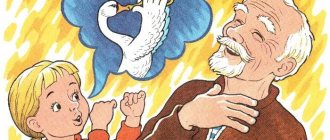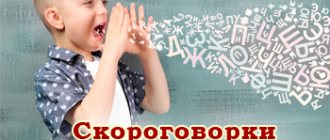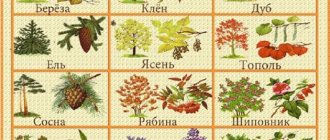The development of speech in children aged 6–7 years leads to the fact that a six-year-old child communicates freely with his peers and adults. If the topic of conversation is familiar to children, they can freely support it, generously sharing their knowledge on the problem and their still small experience.
At this age, intensive development of thinking occurs, which is closely related to the development of speech. A 6-year-old child vitally needs communication with an adult, when he can discuss everything that happens around him: objects, phenomena and relationships with people.
Play is still the main activity for a six-year-old preschooler. Only in the game will he learn and understand new material many times faster than during classes that imitate school lessons. Playing with peers and with older children requires developed speech, otherwise it is very difficult to establish close interaction and satisfy the very important need for a small person to communicate and express emotions. At the end of preschool childhood, speech becomes an important means of communication.
Features of speech of six-year-old children
At this age, the level of children's speech is directly dependent on the speech culture of the adults who surround the preschooler. If the speech of close people is grammatically correct, it often contains vivid epithets, it is rich in content, if adults correct the child’s mistakes in a timely manner, we can say with complete confidence that the child’s speech will have similar qualities.
Lexicon
Children during this period have from three to five thousand words in their active vocabulary. You should not assume that older preschoolers use all this vocabulary in everyday speech; most often, their everyday vocabulary is somewhat more modest. Children do not attach the correct meaning to all words; there are also erroneous interpretations of meanings. Sometimes their speech is clogged with colloquial or slang expressions and phrases.
We must strive to ensure that six-year-old children use words with meaning, use vivid expressions, for example, “in a hurry”, “neither light nor dawn”, know that some words have figurative meanings, for example, “the sun has set”, “ The minutes are passing." The Russian language, despite the fact that it is considered one of the most difficult because of the many rules and exceptions to them, is extremely rich and beautiful. Helping a child master this wealth is the most important task of parents and teachers.
Grammatical structure
Although the speech of a six-year-old child is becoming more and more perfect, there are still errors in it. Children cannot always correctly inflect words by case and number: “no friends”, “many gloves”, “near the houses”. If the word is inflexible, difficulties may also arise with it, for example, “no coat”, “seen in the cinema”. Children's utterances consisting of simple sentences are replaced by complex sentences. For example, “We went for a walk yesterday and saw beautiful water lilies on the lake” or “Give me a car, but not a blue one, but a red one, because it goes faster.”
Teachers working with children and caring parents can already tell which child has the most valuable quality - “a sense of the native language,” when children can spontaneously use new words, change them in accordance with already learned norms and rules, subconsciously focusing on the sound and word form. They enjoy puns when, instead of one meaning of a word, another, similar in sound, is used. Remember the immortal lines about an absent-minded person: “Dearly respected carriage, dear carriage dear! ...Can’t we stop at the tram station?”
Connected speech
This area of children's speech blossoms wildly at the end of preschool childhood. It is not difficult for children to independently retell a work of art, the content of a film, describe an object, a toy, come up with a fairy tale, describe what he feels in different situations. A very useful quality that appears at this age is a sense of foresight, when children can talk about what is about to happen or could happen, but has not happened yet, or come up with a continuation of a story started by adults.
Another achievement is explanatory speech, when it is necessary, for example, to explain to peers the rules of an outdoor game, to agree on roles in a story game or in a tabletop theater performance. This requires special precision of statements and a logical determination of the sequence of actions. For example, when explaining the rules of the game “Third Wheel,” you need to keep in mind the order in which the players are placed, how and under what conditions they change, who is considered the winner, and who is eliminated from the game.
Phonetics of children's speech
The sounds of the native language at this age stage are almost completely pronounced without errors. Children have mastered and clearly pronounce all words, in most cases in accordance with the norms of literary pronunciation. They can speak slowly and quickly (tongue twisters), loudly and quietly, have mastered whispered speech, and widely use intonation.
Occasionally, the following phonetic problems may occur:
- Blurred pronunciation of words and phrases, unclear endings. This defect is most often found in those who have recently mastered the pronunciation of all sounds, and in children with a fast speech rate;
- Fuzzy differentiation of sounds by ear, when a child confuses pairs of sounds: [s]-[ts], [l]-[r], [z]-[zh], [s]-[sh], [ts]-[ h] and others when pronouncing syllable chains, for example, sa-za-sa, la-ra-la, za-za-zha, sa-sha-sa, cha-cha-tsa and others.
- Incorrectly placed emphasis: chauffeur - chauffeur, calls - calls.
At the stage from 6 to 7 years, it is necessary to pay special attention to the formation of phonemic hearing, the ability to do sound analysis: to isolate individual sounds from words, and words from sentences; consistently name sounds in words; determine the place of sound in a word, divide words into syllables. These skills are the basis for learning to read and write; they are more necessary for a child than knowing letters. Without these skills, the child does not read, but mechanically learns syllables and words.
How to help a teenager and an adult with poor diction?
Our center’s specialists also recommend starting with breathing and articulation exercises. Spend at least 10-15 minutes daily on exercises and you will soon see results. But, besides speech physical education, there are proven ways to improve diction.
Reading aloud
Train yourself to read a short text out loud every day. Classes will be more interesting if you train on a collection of humorous stories. O. Henry, Teffi, Hector Hugh Munro, Anton Chekhov - the choice of authors is huge. While reading, pronounce sounds clearly, take your time, pay attention to punctuation marks, and watch intonation. Spend at least half an hour reading aloud.
Tongue twisters, walnuts and pencil
Tongue twisters are a good thing, but they can be a little more complicated if you want quick results. Place one nut on each cheek and try to say a tongue twister, do the exercise for a few minutes. If you don't like walnuts for some reason, use a pencil. Hold it between your teeth and read your favorite poem or tongue twister. By the way, this exercise can be offered to your baby.
Voice recorder and audiobooks
Nowadays every phone has a voice recorder, so recording your speech, for example reading aloud, is not difficult. Listen carefully to the recording and note the sounds that are still difficult for you. Choose tongue twisters where they are practiced. If you like listening to audiobooks, take note of how a professional speaker pronounces the words. Copy his intonation and timbre.
Watch your posture and talk while walking
Due to poor posture, the respiratory organs seem to be in a compressed position. When you straighten your shoulders, your breathing will become calmer, more correct, and it will be easier for you to control it. There is a simple exercise: walk around the room, take a breath and talk, paying attention to your pronunciation.
Preparing a preschooler for reading and writing
Despite the fact that the first grade program is designed for children who come to school not knowing a single letter, parents strive for their children to arrive at school already reading and, preferably, writing. They motivate this by the fact that while the child reaches reading fluency, it will not be easy for him to read and understand tasks in other textbooks: in mathematics, on getting to know the world around him.
Unfortunately, we often see how preschool preparation is carried out by those who do not have the slightest idea about the capabilities of children at 6–7 years old. With such “would-be teachers,” the child begins to master reading without having the skills to analyze words, without being able to determine what sounds a word consists of.
“Homework” that is not designed for the capabilities of a preschooler leads children to feel the incredible difficulty of their upcoming studies. After such classes, they come to school with a negative attitude towards the learning process, which initially should have become a source of joy and new emotions for them.
Preparing to Learn Writing
For learning to write, numerous exercises in copybooks are not as important as special tasks for developing fine motor skills and establishing connections between the eye and hand:
- Unfastening and fastening buttons, complex fasteners, lacing;
- Collecting constructor models, for example, Lego, according to the proposed model;
- Weaving from fabric, thread, paper;
- Unscrewing and screwing in children's construction set bolts and screws;
- Hatching, coloring drawings;
- Laying out like a mosaic;
- Writing graphic dictations.
It is desirable that the child is well oriented on the plane of the sheet and can draw a line along the cells up, right, left, down. These skills will come in handy when he begins to master the correct writing of letters and numbers.
Preparing for literacy
You need to start this complex process not with showing letters, but with the ability to hear the sounds of speech. It’s not at all easy to explain to a child what a word is – you can’t touch or see it. You can play word games “Give me a word”, “Finish the line”. When children understand what a word is, they need to be taught to isolate sounds from the word. For this, they also use various games where an adult pronounces words, highlighting some sound. The child’s task is to determine whether this sound is in the word or not.
Gradually making the task more difficult, children are taught to look for these sounds at the beginning, at the end, and in the middle of a word. For sound analysis of a word, you need cards with drawn cells and chips of two colors made of cardboard. You need to start with words that are simple in sound-syllable structure, for example, consisting of three sounds: cat, house, smoke, bow, ball, where these sounds are pronounced clearly and clearly. When pronouncing a word, an adult intonationally emphasizes all sounds in order. The child must name the sound and cover the square with a chip. This work does not tolerate haste and negligence; the intellectual characteristics of the child must be taken into account; the more capable child should be given more complex tasks; the passive child should be offered help without being discouraged from doing the work.
Having consolidated these skills, the adult teaches children to distinguish between vowels and consonants (the pronunciation of some is interfered with by the tongue, lips, teeth, while others are pronounced without interference), soft (lips smile more) and hard, voiced (there is vibration) and dull sounds. Chips for sound analysis of a word are already becoming multi-colored: red (vowels), blue (hard consonants), green (soft consonants). More complex words are already offered for analysis - from 4-5 sounds.
We gradually complicate the tasks, the adult lays out a diagram of the word, and the child must either choose pictures to go with it, or come up with his own word. While playing, you can help with questions that lead to inventing words. We assemble a ladder, come up with a word where the given sound is on the first, second, third, etc. place. We come up with chains, select a word for the last sound, for example, sledge-willow-August-axe-satchel-flowers. And only after a solid mastery of these skills can you begin to get acquainted with letters. To teach syllabic reading it is convenient to use a special manual. These include Chaplygin's cubes and all sorts of objects consisting of a sheet of cardboard with windows through which a strip with vowels and a second with consonants are pulled. The stripes move to form syllables.
This is an important preparatory period that precedes learning to read and write. It is impossible to skip this stage; such exercises help children easily master the skills of reading and error-free writing, which contributes to normal learning according to the school curriculum.
Word games for children 6-7 years old
Entering school requires a first-grader to concentrate on educational activities. Of course, in the first year or two, teachers still try to include playful moments in the educational process, but still, studying is not toys, but a serious activity that requires willpower, composure and perseverance.
But still, the main activity of a child in the first years of life is play. Through play, kids get to know the world around them:
- learn letters and numbers;
- train memory and attention;
- develop logical and innovative thinking;
- study colors and shapes, seasons and days of the week;
- stimulate creative and emotional intelligence;
- learn the principles of healthy communication with other people.
When the child reaches the age of 6-7 years, when active preparation for school begins, parents often push games into the background, urging their beloved child to get used to the upcoming realities as a student. Yes, you can partially replace educational games with activities that are more similar in structure to a traditional school lesson, but you still need to play during this period and, let’s say, in any other period - right up to old age. Moreover, you can successfully combine learning with entertainment. To help all mothers and fathers anxiously awaiting entry into the ranks of parents of first-graders, here are word games for children of senior preschool age.
Benefits of word games
Verbal games include all games in which the main element is the word. These are various kinds of associations, and chains, and leapfrogs, and even all kinds of crosswords: scanwords, chainwords, fillwords, diwords, etc. Some of them involve organizing leisure time for a large cheerful company, others allow you to spend interesting time alone with yourself. But all word games are united by a common characteristic - they do not require any (well, almost any) additional attributes. Maximum - a pen and a piece of paper, a ball, cards with pictures, words or letters.
You can play word games with children anywhere:
- Houses;
- on a walk;
- on the road;
- queue.
It is well known that at any age, verbal games actively stimulate the development of cognitive mental processes:
- attention;
- memory;
- thinking;
- imagination;
- speech.
We believe that we have convinced you that playing is not a hindrance to studying. This means it’s time to move from words to deeds. More precisely, to the game. Word game.
Word games with ball
"I know…"
The game can be played by any number of participants. You can play alone, then the ball is not thrown from player to player, but bounces off the ground. An excellent activity for training dexterity and coordination of movements, developing memory and attentiveness (after all, words in the game cannot be repeated).
Sitting in a circle, the players throw the ball clockwise to each other, reciting the rhyme:
- I
- I know
- ten (if it is still difficult to name 10 items of the same category, the number can be reduced to 5 or even 3)
- flowers (categories can be very different - female and male names, months, days of the week, colors, geometric shapes, birds, vegetables, etc.)
The following is a list of items and their counting:
- chamomile - once;
- buttercup - two;
- lilac - three...
If the player hesitates and cannot quickly name the flower, he passes the ball further around the circle, and at the end of the game (when all the participants in this category have been named by the joint efforts of all participants), he will have to complete some task (tell a rhyme, sing a song, answer a question). question, jump on one leg, etc.)
"Edible - inedible"
At a time when all the courtyards were filled with groups of children of different ages, residents of nearby houses through open windows could hear for days on end how excitedly children were playing this incredibly popular game at that time. If your childhood passed without it, we will tell you surprisingly simple rules.
From among the players (there can be as many of them as you like, but not less than two), water (the leader) is selected. He stands opposite the rest of the guys and throws the ball to each of them in turn, saying any word:
- cucumber;
- bench;
- house;
- blazer;
- bun...
If the object called water can be eaten, the player catches the ball with his hands and then returns it to the leader. If the word is “inedible”, the ball must be hit. The player who reacted incorrectly to the word changes places with the leader.
Instead of classification by “edibility”, any other characteristic can be used. For example, catch the ball if the named word denotes transport (flower, objects of wildlife...), otherwise, hit it.
"Tender ball"
The game develops dexterity and speed of reaction. Useful at the stage of learning diminutive suffixes. Great for parent-child play. You can play with several children at once, throwing the ball to each of them in turn.
The rules are simple: when throwing the ball to the baby, you say the main word. The child must catch the ball and then throw it to you, calling the word in a diminutive form.
Examples:
- chair - stool;
- eye - little eye;
- sun - sun;
- doll - doll.
"Who's cooking?"
A game to consolidate knowledge about the variety of professions.
The adult names the action and throws the ball to the child, and the child, returning the ball, must name the profession corresponding to this action:
Examples:
- cooks - cook (cook, pastry chef);
- draws - artist;
- writes - writer (journalist, poet);
- builds - builder;
- treats - doctor.
You can change roles: the presenter names the profession, and the players catch the ball and name the appropriate action.
"Earth, water, air"
The presenter names the element (earth, water or air) and throws the ball into the player’s hands. The player must catch the ball and in a split second name the creature that lives in this element.
You can use category names (birds, fish...) and specific names (perch, pike, swallow). The main condition: words should not be repeated. If it is impossible to name the word or there is a repetition, the loser must complete the task of the presenter.
Example:
- water - crucian carp;
- earth - boar;
- the air is a sparrow.
General for word games with a ball
All the games described are suitable for organizing activities with a 6-7 year old child on the street and at home. You can use a small soft ball or skip the ball altogether, simply saying the words of the game one by one. In these educational games, the ball serves several purposes:
- requires successfully distributing attention between several actions (catching a ball and thinking about the correct answer);
- regulates the time for thinking about an answer (the ball should not linger in the player’s hands for more than 3 seconds - by agreement, this time can be extended or reduced);
- adds dynamism and excitement to the game.
Word games to develop logical thinking
"Who's the odd one out"
In early preschool age, tasks for the development of mental processes of generalization were carried out using pictures. The child was asked to select several groups from a series of drawings, combining the depicted objects according to different characteristics (size, color, quantity, purpose, etc.), or, on the contrary, remove the extra picture. For a child 6-7 years old, this game can be played in verbal form. Thus, among other things, figurative thinking, imagination and phonemic hearing are involved.
Name a series of words in which all but one are united by common features. At the same time, the task can be complicated by demonstrating that the same objects have a number of characteristics, and you can select group mates for them based on each of the qualities.
Example:
- Bed, wardrobe, table, chair, sheet.
In this group, the word “sheet” is redundant because, unlike the others, it does not mean furniture.
- Pillow, blanket, sheet, bed, wardrobe.
In this group, like in the previous one, there are the words “bed”, “sheet” and “wardrobe”. The extra word this time is “cabinet”, since it does not denote an object that can be used for sleeping and relaxing.
"Danetki"
Danets are a special type of riddles that perfectly develop logical thinking and teach you to think outside the box and creatively. The player is given a task that requires a solution. To find this solution, the player (several guessers are allowed to participate, then they must ask questions to the presenter in turn) asks the presenter leading questions, to which there can be only three possible answers:
- Yes
- No
- doesn't matter
The goal is to find the right solution in a minimum number of questions. You can add a competitive element by declaring the winner the player who first guesses how to solve the puzzle. Examples of ready-made danettes are available on our website. Having trained on ready-made riddles, you will be able to come up with similar problems yourself.
Puzzles
Riddles are a variant of word games known since ancient times that perfectly develop logic. But we suggest not using ready-made author’s or folk riddles, but composing them, as they say, on the go. Moreover, the players must alternately change the roles of guesser and riddle: first you guess, and the child guesses, then vice versa.
This game task develops the ability to identify the characteristics of an object, recognize objects by description, and compose a verbal description by which one can recognize the object.
Example:
This vegetable is green even when ripe. There is no need to boil or fry it. It can be salted, pickled and fermented.
As you probably guessed, this is a cucumber. If the child cannot guess the riddle, add new conditions. Say that you like to add this vegetable to salad, that it is in your grandmother’s garden beds at the dacha... In general, develop not only your child’s thinking, but also your own. Will come in handy




